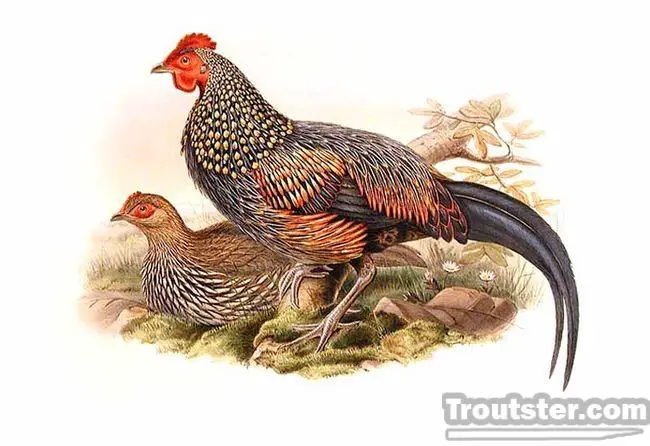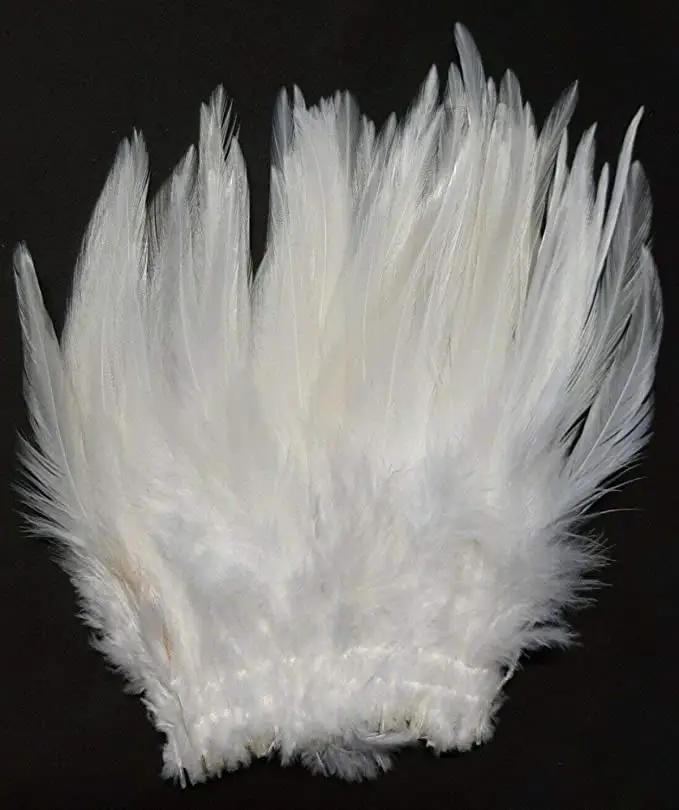This post was last updated on August 7th, 2021 at 09:57 pm
Put most simply, hackles are feathers that are used to make fly fishing ties. These feathers are used to make flies that either sink under water or float on the surface of it, in order to make fish think that the fly is an insect. Some of the most common types of fly tying hackle are saddle feathers, hackle feathers, cul de canard and more. In this article, we’ll discuss the different types of hackle feathers.

Understanding Fly Tying Hackle and Feathers
To understand how to judge the quality of hackle, we should first understand some of the terms used when working with hackle.
- Necks are feathers that are pulled from the region of the bird that begins near the top of the bird, and runs down the middle of the back. These are typically the highest quality feathers used for tying dry flies.
- Saddles are feathers that come from the tail section of the bird. Saddle feathers look different from necks, and are usually cut differently as well.
- Genetic chickens are raised specifically to produce the feather to produce feathers for fly-tying. Cocks or roosters are the males, while hens are the females.
- Capons are genetic chickens are males that have been neutered, specifically so that their feathers will have a certain quality useful for fly tying and fly fishing.
Types of Hackle Feathers
As mentioned above, there are 2 primary choices for dry-fly hackles, and they come from several different parts of the bird – necks and saddles. Hackle feathers are preferred because of their strength and because they’re webbed, which makes them ideal for both dry fly tying and wet fly tying. Different hackles work better for different ties, and buyers should take this into account when buying. Some of the more common fly hackles you’ll see are:
Saddle feather hackles

Saddles feathers come from the rear area and tail of a bird. If taken from a hen, these kind of hackles are mainly used for wet flies, because they’re shorter and they’re webbing is more dense. Because of this, these saddle feather hackle, which are taken from a hen, absorb water better, which helps them to better mimic the movement of insects on the water. If the saddle feathers are taken from a cock or rooster, they’re better utilized for tying dry flies. Saddle feathers take from a rooster have less webbing, and the quill of the feather is typically stronger, which makes the feather stiffer and more rigid. These qualities allow the dry fly to better float on the water because the relative lack of webbing and its stiffness means the feather doesn’t absorb as much water, which means the fly better stays and moves on top of the water.
Cape feather hackles
Cape feather hackles are produced from the shoulders and neck of either a hen or cock. Cape feather hackles are particularly good for dry fly tying, because they’re naturally very strong and stiff, which allows them to mimic the actions of an insect on the surface of the water. Likewise, cape feather hackles don’t have much in the way of webbing, which means they’re not terribly water absorbent. All of this is also why cape feather hackles are not typically the best choice for wet fly tying.
Cul De Canard fly tying hackle

Marabou feather hackles

Like the Cul de Canard, the Marabou is generally pulled from waterfowl or ostrich. They were originally pulled from a specific African bird called the Marabou, but the bird has since been classified as endangered, so the Marabou feather is no longer actually taken from its namesake bird, but rather from a range of other birds. Marabou feathers are very popular feather, generally because of their versatility. Marabou feathers can be used for either dry fly tying or wet fly tying. Marabou feathers are very fine and wispy, and because of this they’re often used to give the impression of legs and antennae of insects on the water.
Ostrich feathers
Another popular choice is ostrich feathers, largely due to the fact that ostrich feathers can also be used for both wet or dry ties. They are very strong, and very long, and they’re used to simulate different parts of an insect. Because they’re so strong and because of their coloring, they’re often used for the tails on streamers. They also tend to pulsate in the water making them rather attractive to fish.
There are many other types of hackle feathers that can be used to make both wet and dry ties. Other common choices include peacock feathers, pheasant feathers, and turkey feathers. Each have strengths and weaknesses, relative to the type of fly you want to build. Understanding the type of fly you want to make is key to judging the quality of any set of feathers.
Judging Quality of Saddle Feathers and Fly Tying Hackle
Now that we’ve covered some of the hackles out there, how do we judge the quality of the hackles? One of the key elements to consider is the source of those hackles. High-quality hackles typically come from birds that are specifically raised to provide hackles. Lesser-quality providers will often take hackles from birds that were raised for some other purpose, and the hackle is essentially a by-product at that point. Hackles from birds raised for that purpose tend to be of much higher quality, and are stronger and work better in water. They also tend to last much longer which decreases the number you’ll need to buy over time. Another important benefit of higher quality hackles are that, because they’re denser than the cheaper product, you don’t need as many to make your flies, which reduces the amount you need to buy.
In Conclusion – Types of Hackle and Fly Tying Feathers
So, given all that, it’s not only important to recognize the right feathers you need, but also to distinguish the quality of hackle that you buy, because both will lead to a better ‘bang for the buck’ over time.

